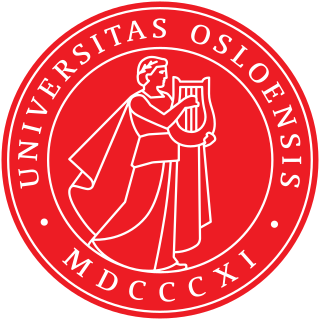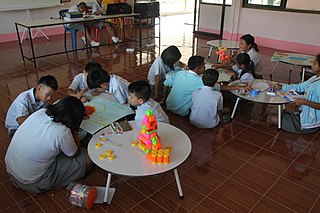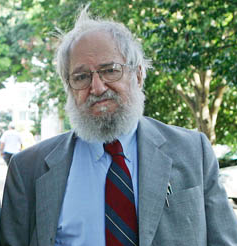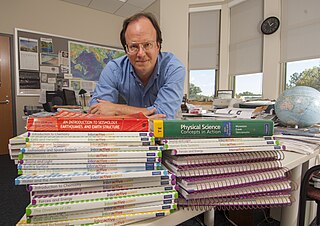Related Research Articles
Progressive education, or educational progressivism, is a pedagogical movement that began in the late 19th century and has persisted in various forms to the present. In Europe, progressive education took the form of the New Education Movement. The term progressive was engaged to distinguish this education from the traditional curricula of the 19th century, which was rooted in classical preparation for the early-industrial university and strongly differentiated by social class. By contrast, progressive education finds its roots in modern, post-industrial experience. Most progressive education programs have these qualities in common:

The University of Oslo is a public research university located in Oslo, Norway. It is the oldest university in Norway and consistently considered the country's leading university and one of the highest ranked universities in the Nordic countries. Originally named the Royal Frederick University, the university was established in 1811 as the de facto Norwegian continuation of Denmark-Norway's common university, the University of Copenhagen, with which it shares many traditions. It was named for King Frederick VI of Denmark and Norway, and received its current name in 1939. The university was commonly nicknamed "The Royal Frederick's" before the name change, and informally also referred to simply as Universitetet.
Science education is the teaching and learning of science to school children, college students, or adults within the general public. The field of science education includes work in science content, science process, some social science, and some teaching pedagogy. The standards for science education provide expectations for the development of understanding for students through the entire course of their K-12 education and beyond. The traditional subjects included in the standards are physical, life, earth, space, and human sciences.

Physical education, often abbreviated to Phys. Ed. or PE, is a subject taught in schools around the world. PE is taught during primary and secondary education and encourages psychomotor, cognitive, and affective learning through physical activity and movement exploration to promote health and physical fitness. When taught correctly and in a positive manner, children and teens can receive a storm of health benefits. These include reduced metabolic disease risk, improved cardiorespiratory fitness, and better mental health. In addition, PE classes can produce positive effects on students' behavior and academic performance. Research has shown that there is a positive correlation between brain development and exercising. Researchers in 2007 found a profound gain in English Arts standardized test scores among students who had 56 hours of physical education in a year, compared to those who had 28 hours of physical education a year.

The educational system in Finland consists of daycare programmes, a one-year "preschool", and an 11-year compulsory basic comprehensive school. Nowadays secondary general academic and vocational education, higher education and adult education are compulsory.

Pedagogy, from Ancient Greek παιδαγωγία (paidagōgía), most commonly understood as the approach to teaching, is the theory and practice of learning, and how this process influences, and is influenced by, the social, political, and psychological development of learners. Pedagogy, taken as an academic discipline, is the study of how knowledge and skills are imparted in an educational context, and it considers the interactions that take place during learning. Both the theory and practice of pedagogy vary greatly as they reflect different social, political, and cultural contexts.

Project-based learning (PBL) is a student-centered pedagogy that involves a dynamic classroom approach in which it is believed that students acquire a deeper knowledge through active exploration of real-world challenges and problems. Students learn about a subject by working for an extended period of time to investigate and respond to a complex question, challenge, or problem. It is a style of active learning and inquiry-based learning. PBL contrasts with paper-based, rote memorization, or teacher-led instruction that presents established facts or portrays a smooth path to knowledge by instead posing questions, problems, or scenarios.

Constructionist learning is the creation by learners of mental models to understand the world around them. Constructionism advocates student-centered, discovery learning where students use what they already know to acquire more knowledge. Students learn through participation in project-based learning where they make connections between different ideas and areas of knowledge facilitated by the teacher through coaching rather than using lectures or step-by-step guidance. Further, constructionism holds that learning can happen most effectively when people are active in making tangible objects in the real world. In this sense, constructionism is connected with experiential learning and builds on Jean Piaget's epistemological theory of constructivism.
Advance HE is a British charity and professional membership scheme promoting excellence in higher education. It advocates evidence-based teaching methods and awards fellowships as professional recognition for university teachers. Founded in 2003, the Higher Education Academy was responsible for the UK Professional Standards Framework for higher education practitioners and merged to form Advance HE on 21 March 2018.
The Storyline method is a pedagogical strategy for "active learning," mainly used in primary schools in Scotland, the United States, Scandinavia and the Netherlands. The system can be adapted for use in adult education as well. It was pioneered by the staff of the Inservice Department of the Jordanhill College of Education in Glasgow, now University of Strathclyde.
The Association of Teachers of Mathematics (ATM) was established by Caleb Gattegno in 1950 to encourage the development of mathematics education to be more closely related to the needs of the learner. ATM is a membership organisation representing a community of students, nursery, infant, primary, secondary and tertiary teachers, numeracy consultants, overseas teachers, academics and anybody interested in mathematics education.
Eklavya is an Indian NGO based in Bhopal, Madhya Pradesh working in the field of education. It was registered as an all India in 1982. The organization is named after Eklavya, the protagonist of a story in the Mahabharat, for his determination to learn even in the absence of a teacher.
St Mark's Catholic School is a co-educational Catholic secondary school and sixth form with academy status, having formerly been a voluntary aided school, situated in Hounslow, West London, England. St Mark’s is part of the Archdiocese of Westminster.

Michael E. Wysession is a professor of Earth and Planetary Sciences at Washington University in St. Louis, and author of numerous science textbooks published by Pearson Education, Prentice Hall and the Savvas Learning Corporation. Wysession has made many contributions to geoscience education and literacy, including chairing the inclusion of Earth and space science in the U.S. National Academy of Science report A Framework for K-12 Science Education and the U.S. K-12 Next Generation Science Standards
The Earth Science Education Unit (ESEU) provided professional development (CPD) workshops and resources for teachers and trainee teachers in Earth science Education across the UK between 2002 and 2015.

Activity-based learning, or ABL, describes a range of pedagogical approaches to teaching. Its core premises include the requirement that learning should be based on doing hands-on experiments and activities. Activity-based learning is rooted in the idea that children are active learners rather than passive recipients of information. If children are provided the opportunity to explore on their own and are provided with an optimum learning environment, then learning becomes more joyful and long-lasting.
Said Hadjerrouit is a professor of informatics and computer science at the University of Agder in Kristiansand, Norway. He got a doctoral degree (Dr.Ing) in 1992 in the field of medical expert systems and artificial intelligence, and a master's degree (1985) in software engineering from the Technische Universität Berlin, Germany. His teaching in Berlin focused mostly on informatics and society, philosophical and ethical issues of computing, and computers in developing countries. In 1991, he moved from Berlin to Kristiansand, Norway, and worked at the Institute of Electronic Data processing at the University of Agder. In 1994, he moved to the Institute of Mathematical Sciences at the same university, where he was appointed as an associate professor for teaching object-oriented programming, Web engineering, software development, and databases. From 2004, his work shifted to didactics of informatics and computer science education, ICT in mathematics education, ICT-enhanced learning, Web-based learning resources, social software, and Web 2.0 technology. In 2008, Hadjerrouit made a major shift in his research focus from didactics of informatics and Computer Science to mathematics education and use of digital tools in teaching and learning mathematics. He has been teaching the doctoral course “Theories in the Learning and Teaching of Mathematics” since 2014. He is also supervising two PhD students in the field of Flipped Classroom and documentational approach to mathematics education. Hadjerrouit has more than 140 publications in international journals and conference proceedings. He was awarded for Best Paper at Society for Information Technology and Teacher Education Conference in San Diego, California, United States, and IADIS e-Society conference 2012 in Berlin, Germany.
Arts-based environmental education (AEE) brings art education and environmental education together in one undertaking. The approach has two essential characteristics. The first is that it refers to a specific kind of environmental education that starts off from an artistic approach. Different from other types of outdoor or environmental education which offer room for aesthetic experiences, AEE turns the tables in a fundamental way. Art is not an added quality, the icing on the cake; it is rather the point of departure in the effort to find ways in which people can connect to their environment. A second fundamental characteristic is that AEE is one of the first contemporary approaches of bringing together artistic practice and environmental education in which practitioners also made an attempt to formulate an epistemology.
Creative education is when students are able to use imagination and critical thinking to create new and meaningful forms of ideas where they can take risks, be independent and flexible. Instead of being taught to reiterate what was learned, students learn to develop their ability to find various solutions to a problem. Coming up with various out-of-the box solutions is known as divergent thinking and there is no one way of cultivating this skill - largely due to the newness of the concept and the limited scientific information on creativity.
Christopher John Henry King (1949–2022) also known as Chris King was a prominent British geologist and science educator known for his extensive work in geoscience education including contributions to international organizations like the International Union of Geological Sciences (IUGS) and the International Geoscience Education Organization (IGEO) and the European Geosciences Union.
References
- ↑ Earth Science Education Unit (ESEU)
- ↑ "Earth Science Teachers' Association (ESTA)". Archived from the original on 2012-01-17. Retrieved 2012-01-29.
- ↑ "The Geological Society of London". Archived from the original on 2011-10-21. Retrieved 2010-11-02.
- ↑ Earth Science Week
- ↑ "University of Wales CELT News". Archived from the original on 2011-03-12. Retrieved 2011-02-03.
- ↑ "Geoscientist August 2007". Archived from the original on 2011-06-05. Retrieved 2010-10-11.
- ↑ Science in School
- ↑ University of West Indies Seismic Research Centre
- ↑ "The Eggs EGU Newsletter". Archived from the original on 2010-10-18. Retrieved 2011-02-03.
- ↑ "ELI Around the World".
- ↑ Dept. of Geology of the University of Buenos Aires
- ↑ AEPECT
- ↑ Investigación y Renovación Escolar
- ↑ Naturfag.no
- ↑ "Geologi.No". Archived from the original on 2011-07-24. Retrieved 2011-02-03.
- ↑ "Naturfagsenteret". Archived from the original on 2011-07-19. Retrieved 2011-02-03.
- ↑ ANISN
- ↑ Department for Geography Education, Institute for Science Education, Leibniz University, Hannover
- ↑ Institute of Geosciences, Campinas State University, Sao Paulo, Brazil
- ↑ Adam Mickiewicz University, Poznan
- ↑ Lepšia Geografia Earthlearnigidea page
- ↑ Geoidea